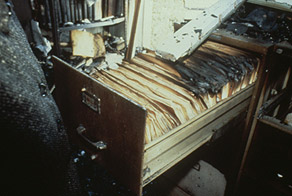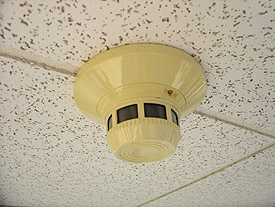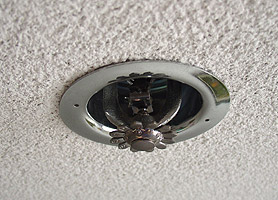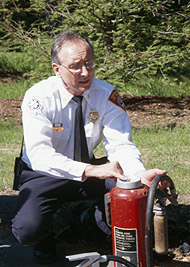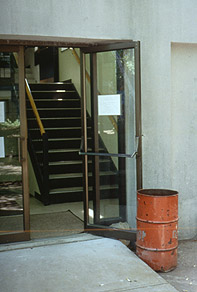
fire protection and security
1 Detection | 2 Suppression | 3 Security Systems and Procedures
|
|
The goal of fire protection and security systems is to protect the building and its contents from damage and theft. Security and fire protection are closely related, as fire protection and security systems are often monitored by the same office or company, and security measures that discourage arson are essential to fire prevention. Fire protection and security are both addressed further in Session 8: Emergency Preparedness.
Fire Prevention
The keys to preventing fire damage are elimination of fire hazards and early detection and suppression of any fire that does occur. Fire protection systems must be monitored 24 hours a day by an outside agency (e.g., an outside security company, the local fire department, or the institution's own security force) and inspected and maintained routinely to ensure that they will work properly when needed.
Most local fire departments will provide fire inspections and assist institutions in developing a fire safety program. Hazards such as poor electrical wiring and obstructed exits must be corrected. If the fire department is familiar with the building and collections in advance, there is a greater chance that fire-fighting strategies will take collection priorities into account. Frequent fire drills and an updated evacuation plan are also very important.
See the Preventing/Mitigating Disaster: Fire Damage section in Session 8 for a Fire Damage Prevention Checklist.
1 Detection
Fire detectors commonly found in cultural institutions are manual fire alarm pulls (which provide a quick way to activate the alarm system during occupied hours), heat detectors, and smoke detectors. Often a combination of different types of detectors will be used, depending on the building construction and other needs. Detection systems often play a part in activating the fire suppression system.
Heat Detectors
Fixed-temperature heat detectors are designed to operate when the room reaches a predetermined temperature (usually a fairly high one). These do not detect smoldering fires well. Rate-of-rise heat sensors are better, since they are activated by a sudden, small increase in temperature, but in general heat sensors do not work until the temperatures in the room are quite high and the fire is likely to be well developed.
Smoke Detectors
|
|
Smoke detectors are designed to detect a fire while it is still in its incipient stages. There are several types (photoelectric and ionization) that work on different principles. Smoke detectors are usually spot units that are placed along ceilings or high on walls. A third type of detector, the air aspirating system, is very sensitive to smoke and might be considered for areas in which extremely valuable collections are stored. These units draw an air sample in, analyze it, and then return it to the space. If smoke is detected, the alarm system is activated.
System Controls
The control panel of a detection system monitors the various detectors within the system, as well as the devices that announce or respond to the alarm (bells, lights, building HVAC controls). There are two basic types: conventional and addressable. Conventional systems usually have several zones, each of which may have a number of smoke detectors and manual pull stations. An alarm in one zone cannot indicate which specific detector was activated, so depending on the size of the zones, fire personnel may have to search for the fire. Addressable systems are more complicated and expensive, and they require more training of building maintenance personnel. However, they can indicate which specific alarm has been activated and detect any faults in the system circuits.
For more information on fire detection and suppression systems, see the NEDCC Preservation Leaflet An Introduction to Fire Detection, Alarm, and Automatic Fire Sprinklers. Always contact an appropriate fire professional to determine the best type of fire protection system for your building.
2 Suppression
A number of different types of suppression systems have been used in cultural institutions over the years. Modern wet-pipe sprinkler systems are increasingly recommended for cultural institutions due to their relative low cost, ease of maintenance, and dependability.
Sprinkler Systems
Water sprinkler systems consist of the sprinklers themselves, the piping system, and a water source. Systems are usually also equipped with water flow alarms (to indicate when a sprinkler is activated), control valves (allowing the system to be shut down), and features that allow the pipes to be drained for maintenance and tested periodically.
|
|
Sprinkler heads are activated by high temperatures. In modern systems, sprinkler heads operate independently of each other; only the sprinklers in the immediate vicinity of the fire are discharged. On/off heads that close when the temperature is reduced are available, but they are not generally recommended due to their high cost and the fact that fire personnel normally arrive to shut down the system before the temperature is reduced enough to close the sprinkler heads. The rate of accidental sprinkler discharge has been estimated at 1:1,000,000 heads or better, and studies have indicated that 70% of library fires are extinguished by three or fewer sprinkler heads.
There are three main types of sprinkler systems:
- Wet-pipe systems are the most common, the most reliable, and the easiest to maintain. Water is maintained in the pipes at all times, and when a sprinkler head opens it is discharged.
- In dry-pipe systems, the pipes are filled with air, which is released when a sprinkler head opens, allowing water to flow into the pipes and to the fire. These have a slower response time, but are useful in areas where freezing of the pipes might occur.
- Pre-action systems work with the fire detection system; when some combination of detectors indicates a fire, a valve is opened to allow water into the pipes. The water is not discharged, however, until a sprinkler head is activated. These systems are expensive to install and maintain, and they have a higher risk of malfunction.
Water Mist Systems
In recent years the water mist system has emerged as a new fire suppression option. These systems discharge water in very fine droplets at high pressure, which maximizes the water's cooling capacity and suppresses the fire with much less water than conventional sprinkler systems. A typical sprinkler uses 25-72 gallons of water per minute; water mist systems in testing have extinguished library and archival fires with only 1 to 5 gallons of water; and fire department hoses typically deliver 100-500 gallons per minute.
Gas Suppression Systems
Gas suppression systems extinguish a fire by flooding a space with a gas to reduce the oxygen concentration, so that insufficient oxygen is available to fuel the fire. These systems can only be used in storage areas, because they pose the danger of asphyxiation to people.
In previous years, numerous institutions installed Halon gas suppression systems. New production of Halon has been phased out (due to its effect on the environment), and while several substitutes have been developed, none has emerged as a completely satisfactory replacement. Options include FM-200 and Inergen, both of which are costly and must be used at high concentrations, requiring the storage of large amounts of the gas.
Fire Extinguishers
|
|
Fire extinguishers are rated according to the types of fire they put out. Class A extinguishers are used for ordinary combustibles such as wood or paper. Class B extinguishers are used for fires involving flammable liquids (e.g., oil, grease). Class C extinguishers are used for electrical fires.
Dry chemical extinguishers (also known as ABC extinguishers) are usually rated for multipurpose use. Water extinguishers (standard or mist) should only be used on Class A fires. CO2 extinguishers are most effective on Class B and Class C fires. Staff must be trained in the use of fire extinguishers, and extinguishers must be inspected annually.
3 Security Systems and Procedures
Security must be a concern in collection stewardship. A basic security policy with preventive activities and proper response procedures is critical to the protection of building, collections, staff, and patrons. Security preparations can be coordinated as part of the emergency plan or as a separate parallel security plan.
Security Systems
Automated security systems have several advantages: they can act as a deterrent to intruders, they will detect an intrusion in progress, they will notify appropriate personnel about the incident, and they can provide a means to connect other alarms (water alarms, etc.) to a monitoring station.
Security systems secure perimeter access points such as doors and windows, and they protect interior spaces via motion detectors. A system is made up of sensors, a control panel (which receives reports from the sensors and controls the alarm), and reporting devices (a traditional alarm or some type of signal to a monitoring station). A security system must be monitored 24 hours a day to be effective. This may be done by an outside monitoring company, or in the case of larger institutions, by an in-house or campus security office.
Security Procedures
|
|
While an automated security system can greatly enhance security, such a system should never be your only protection. Enhance perimeter security by increasing exterior light levels, expanding light coverage, clearing bushes and debris, and securing windows, doors, and skylights. During working hours, insist that all staff and patrons enter and exit by a single, monitored doorway. Alarm all other doors for unauthorized use. Carefully control building keys and keys to special collections areas, and keep a strict record of all keys issued and returned as employees come and go. It is also very important to register and supervise all patrons who use special collections, to track the use of these collections using call slips, and to retain all written records of use in case of loss.
See Session 8: Emergency Preparedness for more information on security, and for a Security Checklist.
For additional information (including a sample patron registration form), see the NEDCC Preservation Leaflet Collections Security: Planning and Prevention for Libraries and Archives.

